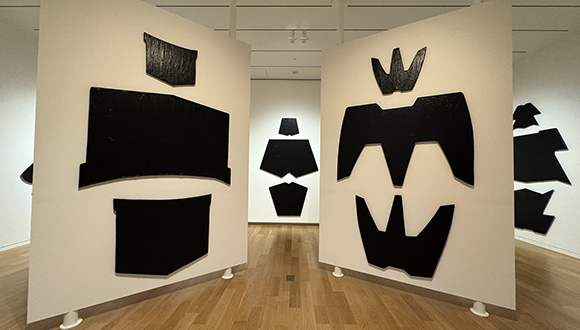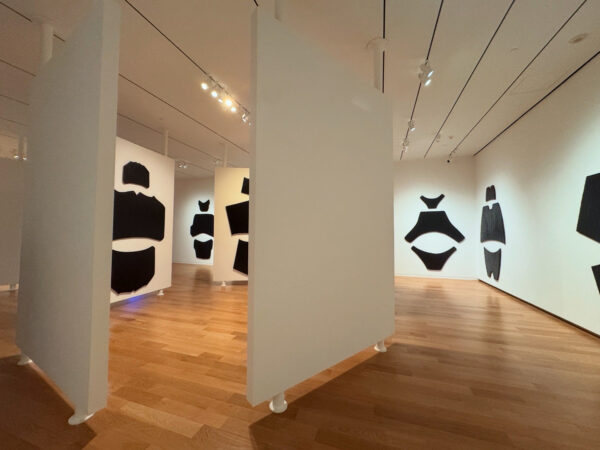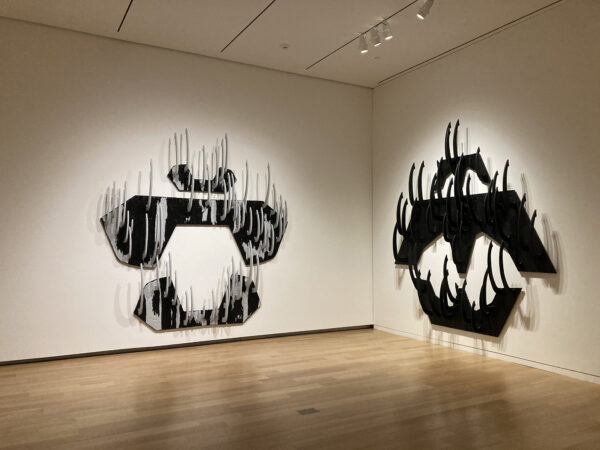David-Jeremiah’s output exceeds even some artists multiple decades into their career. Organized by guest curator Christopher Blay, The Fire This Time at the Modern Art Museum of Fort Worth is a crucial moment for the North Texas arts community, featuring a homegrown talent (David-Jeremiah hails from Oak Cliff). The exhibition not only continues the Modern’s legacy of championing emerging artists but firmly establishes David-Jeremiah’s work as a powerful force challenging cultural narratives and visual norms.
The central focus of the exhibition is the artist’s striking Hood N****s Camping series, a body of work that rejects easy categorization. Colossal, anthropomorphized forms loom over ten feet tall. They are constructed from shaped wood panels modeled directly after the hood designs of Lamborghini cars, arranged as massive vertical triptychs to suggest a head, torso, and legs. While all share a basic “bodice and skirt” form, the artist manipulates the silhouette across the body of work. Some forms are relatively contained, suggesting a poised or monumental presence, while others are aggressively fragmented and re-spaced, cleaving the figure into discrete, geometric shapes that hover and interact. This calculated spacing transforms the triptych from a set of simple cutouts into a dynamic exploration of presence, absence, and the rhythm of the gaze across a starkly modern plane.
Installation view of “David-Jeremiah- The Fire This Time,” at the Modern Art Museum of Fort Worth
A core conceit here is the forceful juxtaposition of extremes. David-Jeremiah links the mythos of the Lamborghini — a hyper-masculine symbol of opulence, technological power, and Western prestige — with the complex, often traumatic, lived experience of “the hood.” Initially, many of these figurative sculptures appear shrouded in a thick, black, tar-like texture, creating a visually stark and imposing presence against the white gallery walls. Material choice and scale of these works ask the viewer to confront the contradictory forces that shape modern identity and the way society often weaponizes traits like power and agency against individuals. Both imposing monuments to wealth and deeply personal reflections on a specific social reality, the segmented figures create a visual language that emulates prehistoric mythmaking.
The installation itself transforms the museum gallery into an “inverted-performance,” a term coined by the artist. Huge, figurative structures are arranged in clusters that echo ancient ceremonial sites like Stonehenge and the intimate, communal feel of a gathering around a fire. Blay notes that the monumental figures draw a correlation between the ancient site and concepts of sacred ground, human exchange, and spirituality. This deliberate staging suggests that the works are not performing for the audience; instead, the audience is prompted to complete the work’s performative aspects. As viewers interact with the structures and contemplate their arrangement, they become, conceptually, the points of ignition — the source of energy, the “fire” that brings light and meaning to the scene.
Installation view of “David-Jeremiah- The Fire This Time,” at the Modern Art Museum of Fort Worth
As the exhibition progresses into the rear galleries, the mood shifts dramatically with the polychromatic EE (Emma Esse) set, which completes the overall body of work. Here, the triptychs break free from the monochromatic black. They are set ablaze with undulating, arching panels that suggest flames coursing and building to a crescendo across the surface. Fire here acts not only as a motif of destruction but as a crucible for purification. The artist describes the process as a “burning away” of limitations and classifications, revealing a spiritual essence.
Installation view of “David-Jeremiah- The Fire This Time,” at the Modern Art Museum of Fort Worth
The exhibition’s title, The Fire This Time, is a direct reference to James Baldwin’s 1963 book of essays, The Fire Next Time. By invoking Baldwin, David-Jeremiah grounds his work in a prophetic conversation about race, trauma, and transcendence in the American context, inviting deep engagement with the possibility of transformation through struggle. Like his similar paintings from the earlier I Drive Thee series, where a canvas was literally cremated and exhibited in an urn, fire symbolizes ritual, transformation, and healing, a process the artist tethers back to universal concepts of humanity and ritual. This exhibition pares down the artist’s robust oeuvre, which includes performance and video. Earlier in his career, particularly with the I Heart Micah series, the artist demonstrated a more overtly confrontational approach to trauma and institutional critique, creating videos of subversive acts and sculptures that encased politically-charged slogans in layers of bulletproof glass. These foundational works established his practice of transforming raw anguish from contemporary issues into potent, formally rigorous meditations on social ritual and the complex burden of American memory.
In championing a local artist whose work sits at the intersection of abstraction, conceptualism, and raw social narrative, the Modern Art Museum of Fort Worth and curator Christopher Blay have presented an exhibition that is both intellectually rigorous and visually overpowering. David-Jeremiah’s show is a must-see for anyone interested in how the complexities of individuality and Black masculinity in America are being explored on a towering scale today, leaving the viewer with profound questions about power, identity, and spectacle.
David-Jeremiah: The Fire This Time, curated by Christopher Blay, is on view through November 2, 2025, at the Modern Art Museum of Fort Worth.




